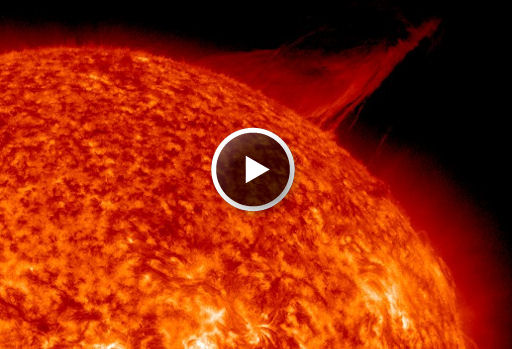They came from outer space--and you can have one! Genuine meteorites are now on sale in the Space Weather Store. | | | CALM BEFORE THE STORM? Solar activity remains generally low, but the quiet is unlikely to persist with so many sunspots turning toward Earth. NOAA forecaters estimate a 30% chance of M-class solar flares during the next 24 hours. Solar flare alerts: text, voice. MOON AND JUPITER: If it's dark where you live, go outside and look up. The nearly-full Moon and Jupiter have gathered together only a few degrees apart. Here, Shahrin Ahmad points out the bright conjunction over Kuala Lumpur, Malaysia: 
"It's always fascinating to compare the size of the objects in the universe," comments Ahmad. "My finger can easily cover the Moon and Jupiter, as well as the nearby mosque's minaret. But it is all insignificant if we realize the true size of these celestial objects!" Readers in North America, where night is falling now, should look for the Moon and Jupiter rising in the east after sunset: sky map more images: from C B Devgun SPACE of New Delhi, India; from Paulo Casquinha of Setubal, Portugal; from P-M Hedén of Vallentuna, Sweden; from Jim Tegerdine of Marysville, Washington; from Daisuke Tomiyasu of Higashinada, Kobe, Japan SOLAR ERUPTION: A teepee-shaped magnetic prominence that solar astronomers had been monitoring for days erupted this morning. NASA's Solar Dynamics Observatory recorded the action: 
Although much of the prominence fell back to the sun, some of the structure did fly into space, producing a coronal mass ejection. SOHO coronagraphs of the CME show that it is propagating up and out of the plane of the solar system: movie. Probably no planet will be hit by the expanding cloud. more images: from Alan Friedman of Buffalo, NY; from Jesús Carmona de Argila of Madrid (SPAIN); from Rogerio Marcon of Campinas SP Brasil; from Karzaman Ahmad of Langkawi National Observatory; from Paul Haese of Glenalta, South Australia; from Robert Arnold of Isle of Skye, Scotland; from Monty Leventhal OAM of Sydney. Australia Potentially Hazardous Asteroids ( PHAs) are space rocks larger than approximately 100m that can come closer to Earth than 0.05 AU. None of the known PHAs is on a collision course with our planet, although astronomers are finding new ones all the time. On October 13, 2011 there were 1250 potentially hazardous asteroids. Notes: LD means "Lunar Distance." 1 LD = 384,401 km, the distance between Earth and the Moon. 1 LD also equals 0.00256 AU. MAG is the visual magnitude of the asteroid on the date of closest approach. | | The official U.S. government space weather bureau | | | The first place to look for information about sundogs, pillars, rainbows and related phenomena. | | | Researchers call it a "Hubble for the sun." SDO is the most advanced solar observatory ever. | | | 3D views of the sun from NASA's Solar and Terrestrial Relations Observatory | | | Realtime and archival images of the Sun from SOHO. | | | from the NOAA Space Environment Center | | | the underlying science of space weather | | | for out-of-this-world printing and graphics | | 
